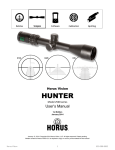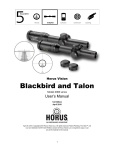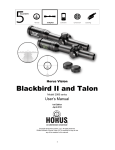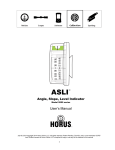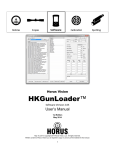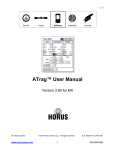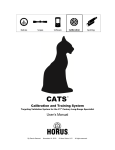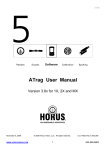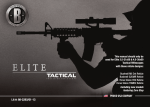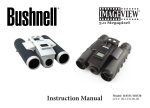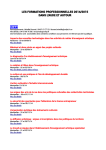Download User`s Manual - Horus Vision
Transcript
Horus Vision® Talon Model 2000 series User’s Manual 2nd Edition February 2013 February 21, 2013. Copyright 2013 Horus Vision, LLC. All rights reserved. Patent pending. Written consent of Horus Vision LLC is required to copy or use any of the material in this manual. 1 CONTENTS Introduction ........................................................................................................................................................................... 3 About Horus Vision .................................................................................................................................................... 3 Safety Warning ........................................................................................................................................................... 3 Getting Started ...................................................................................................................................................................... 4 Mounting Your Horus™ Scope .................................................................................................................................. 4 Zeroing Your Horus Scope......................................................................................................................................... 5 Elevation and Windage Turrets .................................................................................................................................. 6 Slipping the Dials to Zero ........................................................................................................................................... 7 Introduction to Talon™ Rapid Acquisition Rifle Scope .................................................................................................... 8 Key User Controls ...................................................................................................................................................... 9 Characteristics of the Talon ..................................................................................................................................... 10 H50™ Reticle ....................................................................................................................................................................... 11 Key Features ............................................................................................................................................................ 12 Illumination ............................................................................................................................................................... 13 Additional Information ........................................................................................................................................................ 14 Technical Data ..................................................................................................................................................................... 15 Talon Scope Specifications ...................................................................................................................................... 15 H50 Reticle Specifications ....................................................................................................................................... 16 General Care ........................................................................................................................................................................ 19 Warranty ............................................................................................................................................................................... 20 Legal Notice ......................................................................................................................................................................... 21 Contact ................................................................................................................................................................................. 22 2 INTRODUCTION ABOUT HORUS VISION Horus’ cutting-edge technology improves shooting accuracy at extended ranges and increases the likelihood of a firstround hit. Our patented reticles reduce the need for manual scope manipulation and mental calculation. Horus’ simplified shooting system improves accuracy at any distance and can make anyone an expert marksman. Horus’ ATrag™ ballistics software algorithms were developed and refined by the former chief of ARDEC's small-arms division, William C. Davis. Horus Vision was founded in 2000 and is headquartered in San Bruno, California. SAFETY WARNING Always use great care with all firearms. A mistake in judgment or lapse of attention can result in serious injury or death. The information in this manual, while believed to be accurate at the date of publication, is not warranted or represented to be accurate, correct, or useful for any particular purpose. Use the information in this manual with caution and common sense, and verify it with respect to your own firearms before use. The author and publishing company accept no responsibility for errors in the information presented herein, or for accidents, injuries, damage or any other problems which might arise as a result of your use of the information contained in this book, and expressly disclaim all liability for injuries, death and damages, whether direct, incidental, consequential, punitive or otherwise. 3 GETTING STARTED MOUNTING YOUR HORUS SCOPE The Talon requires 30mm rings, which are available in steel and aluminum. While steel rings offer enhanced durability under battlefield conditions they also weigh more. Rings are generally available in four different heights: low, medium, high and extra high. The choice depends upon your rifle’s configuration and your normal body position on the rifle. Rings may come attached to a one-piece base or as separate units. Separate bases or other “riser” type mounting systems may also be used for raising scope height. 1. Mount the bottom portion of the rings to the rifle’s mounting rail, making sure that the spacing is correct so the rings won’t interfere with the scope’s turrets. 2. Place the scope on the bottom portion of the rings, positioning it far enough rearward to provide a clear field of view (FOV). 3. Attach the top portion of the ring, tightening the screws enough to prevent the scope from falling out of the mounts, but loose enough to enable you to adjust the scope forward and aft and to rotate the scope to ensure a level reticle. 4. Focus the ocular by adjusting the rear-most ring on the eyepiece. The reticle should be crisp against a distant object or bright surface. The diopter is adjustable to +/- -2, +1 so the scope can be used with or without corrective lenses. 5. To establish proper eye relief, hold your rifle in a stable shooting position and close your eyes. Position the rifle into your shoulder as if firing, and then open your eyes. If the eye relief position is correct, you shouldn’t see any black or hazy outer ring (vignette effect) within the FOV. If the image is not complete or clear, lower the rifle and gently slide the scope forward or aft in the rings, and then repeat the above exercise. It helps to have someone move the scope while you maintain position. Continue this procedure until the image is correctly viewed through the eyepiece when you open your eyes. Once you’re satisfied that the scope is properly aligned on the rifle, repeat this exercise four or five times in quick succession to ensure that your positioning is correct. If you intend to fire from alternate positions regularly, check eye relief in those positions as well, since they’ll change the relationships between shoulder, head and arms. Set up your eye relief for whatever body position you will most likely use the majority of the time. 6. Before tightening the top portion of the rings, place a spirit level on the elevation turret to check level against the rifle’s receiver. If the rifle has a Picatinny top rail on the receiver, use that surface as the index to level the scope off of. If no rail is available, use the best horizontal surface you can find, such as the bottom metal portion of a bolt action with the floor plate open or magazine removed. While leveling the reticle by eye will work at close ranges, minor level errors will affect use of reticle grid and knob adjustments at farther targets. 7. When satisfied with eye relief and reticle level, tighten the scope ring screws to 15-20 inch-pounds of pressure. Over-tightening can damage the scope tube. 4 ZEROING YOUR HORUS SCOPE While our scopes can be zeroed at any distance, it is recommended that the zero be exactly 100 meters or yards. Regardless of zero range, it is critical that the measurement be precise. The following recommended method of zeroing will eliminate problems while saving time and ammunition: 1. Measure the distance from the rifle to the target to ensure a precise “zero” measurement. 2. Use an 18x18-inch (or larger) sheet of paper with ½-inch vertical and horizontal lines drawn to intersect at the center of the paper. Use a plumb or level to attach the paper to a target backer so that the lines are level. 3. Set your scope power ring to maximum power (Talon 4x), and make sure the elevation and windage turrets are set to 0. 4. Superimpose the Horus reticle over the vertical and horizontal lines on your target to center the reticle precisely on your intended point of impact (POI). 5. Fire your first shot. Adjust windage and elevation knobs to center the shot at the intersection of the vertical and horizontal lines on your target. If the round’s impact is observable, use the Horus reticle’s mil-based grid to measure your deviation from the intended POI, then dial the exact corrections (in 0.1 mil increments) using the knobs to aid in rapid zero. For example, if your first shot impacts 2 mils low and 1.5 mils right, dial 2 mils (20 clicks) up and 1.5 mils (15 clicks) left. You’ll find zeroing with the Horus reticle to be much faster than conventional reticles. 6. Center the reticle over your intended POI and fire another round. Repeat steps 5 and 6 until repeated shots are successfully centered at the intersection of the target’s vertical and horizontal lines. 7. Fire a five round group at a clean target. Adjust zero as needed and confirm with additional groups until it perfectly matches your intended POI. 8. Tighten the turret covers on the elevation and windage knobs. From this point on, use only the gridlines on the Horus reticle – not the knobs – to make adjustments for wind and elevation. Remember to always verify your zero and develop data with the ammunition that you will be using for any sport shooting or hunting purpose. 5 ELEVATION AND WINDAGE KNOBS Your Horus scope is designed to allow all windage and elevation adjustments to be made within the reticle, as opposed to the conventional method of dialing target knobs or ballistic drop compensating (BDC) knobs. However, your Horus scope also has knobs for elevation and windage adjustments with audible clicks, eliminating the need to take your eyes off the target. Rotate clockwise for up/right adjustment. Unscrew and remove the knob cap by turning it counter-clockwise in relation to the scope’s body. Use the elevation knob on top of the scope to make adjustments for bullet drop compensation. Rotate the elevation knob clockwise to move the intended point of impact (POI) up in the field of view, rotate counter-clockwise to move the intended point of impact (POI) down in the field of view. Use the windage knob on the right side of the scope to make adjustments for wind compensation. Rotate the windage knob clockwise to move the intended POI right in the field of view, and rotate clockwise to move the POI left. Each increment (or click) equates to a 0.1 mil change to the bullet impact point, and 10 clicks is equal to 1 mil. When finished making adjustments, return the knob cap to the knob and secure by turning it clockwise. 6 SLIPPING THE DIALS TO ZERO Your Horus scope is designed to allow all deviations from zero for windage and elevation to be made within the reticle, as opposed to the conventional method of dialing target knobs or ballistic drop compensating (BDC) knobs. However, you may elect to index the elevation and windage adjustment knobs on “0” once the rifle is zeroed to allow a return point for zero in the event you adjust the knobs for any reason. To slip the scales in this manner, loosen the two (2) small set screws on the face of the windage and elevation knobs (the viewable sides with numbers on them) using the jeweler’s flat-blade screwdriver included with your scope. Be very careful not to lose these tiny screws. The scale will rotate freely around the knob once the screws are removed. Carefully rotate it until the “0” mark indexes on the small white dot on the scope’s saddle, as depicted below in Figure 3. Take care not to inadvertently turn the inner drum while performing this procedure, as it will adjust the scope’s zero point. Once the knobs have been slipped to “0”, reinstall and tighten the set screws, taking care not to strip them by over-tightening. Always verify zero before capping the knobs. Important: Do not attempt to loosen the screws inset into the top face of the windage and elevation knobs, these are only to be removed by a Horus Vision authorized warranty station. Figures 1-3: Slipping the elevation and adjustment knobs’ scales to “0” will provide a definitive index point to return to in the event you ever adjust them off zero. 7 INTRODUCTION TO TALON RAPID ACQUISITION RIFLESCOPE While traditional tactical reflex and magnified optics are functional, they’re limited by their designs to specific ranges. Tactical shooters need the ability to quickly and accurately engage threat targets from several feet to many hundreds of meters. Conventional reflex sights are unequaled for their ability to quickly acquire targets due to zero magnification and high contrast reticles but are very limited in range. Longer range scopes such as those used by Designated Marksmen and snipers are high quality tools that allow shooters to place precision fire at extreme distances. Horus’ Talon scope bridges the gap between these two capabilities, allowing you to engage intermediate targets with accuracy and closer threats quickly and effectively. Horus’ Talon scope has years of battle-proven performance to its credit. The Talon is best suited for those environments requiring no magnification – such as CQB-type shooting – with the potential need to make intermediate range shots. While the Talon’s H50 reticle allows engagement at farther ranges, its 4x magnification does not lend itself to the longrange, precision aiming that is possible with other, longer-range Horus reticles. However at 1x (zero magnification) the Talon allows immediate acquisition and engagement with a prominent reticle design and wide field of view. The Talon is a superb optic for urban, jungle and other limited distance environments as well as for use on shorter range weapon systems. Table1. Talon features Talon 1-4x24 power Illuminated Horus H50 reticle Rapid engagement reticle features: Moving target lead lines Bold rapid-engagement ring 8 KEY TALON USER CONTOLS Figure 4: The Horus Talon is our general purpose, fast-acquisition optic for close- to mid-range use against threat targets and dangerous game; intended for shooters requiring a zero magnification (aka “unity” or 1x) capability. Talon user controls: 1. 2. 3. 4. 5. 6. 7. Rapid focus eyepiece Zoom/power adjustment ring Windage knob (capped) Elevation knob (capped) Rheostat knob / battery compartment (capped) 30 mm tube 24 mm objective 9 CHARACTERISTICS OF THE TALON: Zero or very low magnification, variable to mid and high powers Rapid acquisition of targets Talon at 1-4 power is the quintessential QCB scope Durable, one-piece 30mm tubes Fast focus eyepiece Illuminated reticle Accurate range-finding to within 0.5 mil No need to “dial in” elevation and windage adjustments for each shot Rapid transition between targets at multiple ranges without altering the shooter’s cheek-to-stock “weld” or body position Reticle allows continuous sighting through scope, eliminating the need to view BDC or target knobs “Fail Safe” system for Second Shot CorrectionTM of observed impacts at highest magnifications Shooter and spotter system for accurate talk-on to targets (when using Horus reticles in both rifle and spotting scope) Enhanced ability to self-spot for range-finding, windage, moving target leads and follow-up shots at highest magnifications Reticle placement in the first focal or image plane (1FP), allowing calibrated use of all mil measurements and holds at any magnification Milliradian-based / metric range finder and measuring scale 34.9 Mils (120 MOA) elevation & windage adjustments 0.1 mil (1 cm at 100 meters) click adjustments 11 brightness settings on rheostat control Illumination powered by a single CR2032 battery 10 H50 Reticle The H50 easily switches between eliminating close threats and mid-range targets. For close threats, use the bold aiming ring at 1x zoom. For longer-range targets to 600+ yards, use the Standard Horus Grid which appears below the main horizontal crosshair. It’s a versatile combination for incredible speed and distance advantage. Marks on the main horizontal crosshair approximate leads for walking, running, and sprinting targets. See Figure 5 (right). 1. CLOSE RANGE: The H50 presents a ‘bold ring’ with a central “crosshair”. It is best to use One power (1x) to achieve the maximum field of view for targets at close ranges. At low power the bold ring is seen as a very large aiming circle while the central reticle virtually disappears. 2. MID-RANGE: To use the H50 at mid-range, place the optic on Three (3x) or Four power (4x). The bold ring allows the eye to be quickly centered naturally on the reticle’s center and additional elevation aiming points will be visible below center. Figure 5: The H50 reticle shown at 1x zoom for close range targets (LEFT) and 4x zoom for mid-range targets (RIGHT). 11 H50 KEY FEATURES: Uniform grid etched on optically superior glass Standard Horus Grid reticle hold points subtending to 0.5 mil for ease of use at 4x 12 mils of total elevation hold within the reticle Open center for accurate aiming on small targets Moving target measurements along horizontal stadia: 4 = 4 mph the speed of a man fast walking 8 = 8 mph the speed of a man running 12 = 12 mph the speed of a man sprinting 16 = 16 mph the speed of an APC 20 = (using the bold ring) 20 mph Precise calibration of measurements to within 0.5% Heavy bold ring for rapid engagement of close targets Rheostat adjustable illumination of specific elevation hold points, bold ring and crosshair portions of reticle. Very bright settings for fast engagement at low power Rapid range-finding capability for personnel-sized targets Figure 6: Key H50 reticle features. 12 ILLUMINATION The H50’s bold ring, vertical and horizontal stadia all illuminate fully. Illumination at low power can be varied from extremely bright for daytime use to minimal for limited visibility. Figure 7: The H50 reticle’s illumination pattern shown at 1x zoom (LEFT) and 4x zoom (RIGHT). 13 ADDITIONAL INFORMATION Horus scopes and reticles make the complex process of precision shooting faster and easier. From the point where you identify a target, to the point where you follow-through to confirm the hit, there are several critical steps where Horus technology makes a difference: 1. 2. 3. 4. Ranging Use of grid for holdover Wind holds and/or moving target lead lines Follow-through and Second Shot CorrectionTM You can explore these steps in greater detail in the Horus Vision Tactical Manual. Please refer to it for proper application of these steps. Increase Accuracy with ATragMXTM Ballistics Software For even greater accuracy, Horus ATragMX Ballistics Software can be used in combination with your Horus scope and reticle. Our ballistics software lets you take combat-proven aiming solutions into the field so you are instantly ready for any shooting conditions. ATragMX enhances any mil-based reticle system, but it is not required. To learn more about the benefits of Horus Ballistics Software, see the ATrag User Manual. 14 TECHNICAL DATA Figure 8: Talon scope technical drawing with specs. TALON SCOPE SPECIFICATIONS Battery Life.................... 20+ hours Rheostat ....................... yes Rheostat Positions ........ 11 positions Lenses .......................... 12 + reticle Lens Coating................. multi-coated Objective Lens .............. 24mm Field of View ................. 21.0 - 9.0 m (at 100m) Eye Relief ..................... 5.5" - 3.3" (139-84mm) Exit Pupil ....................... 24.0 - 6.0 mm Ocular Type .................. rapid European focus Diopter Adjustment ....... more than (-2,+1) Elevation Increment ...... 1 click = 0.10 mil radian (1 cm at 100 meters) Elevation Adj. Range .... more than 34.9 MILS Windage Increments..... 1 click = 0.10 mil radian (1 cm at 100 meters) Windage Adj. Range ..... more than 34.9 MILS Turret Caps ................... yes Turret Type ................... low Power Selector Style .... tactile power indicator Power ............................ 1-4x Length ........................... 9.75" (24.8 cm) Weight ........................... 18.3 oz (518 g) Tube Diameter .............. 30 mm Wall Thickness.............. 1.5mm Material ......................... aluminum 6061-T, 340 HV Hardness Tube .............................. 1 piece Color ............................. black Exterior Finish ............... matte anodized Shockproof.................... 1200 g Water-resistant ............. yes (3 meters) Dustproof ...................... yes Fogproof ....................... yes Warranty ....................... 1 year limited Twilight Factor .............. 4.9 @ 1x - 9.8 @ 4x Reticle ........................... H50 Reticles ......................... 1st Focal Plane Reticle Illumination........ yes Battery .......................... CR2032, requires one 15 H50 RETICLE Features: Bold ring and crosshairs illuminate, rheostat adjustable Target lead indicators on horizontal crosshair, 4mph-20mph Calibrated in USMC Mils (6283 mils/circle) (1 mil = 3.60 inches at 100 yards) Point-blank to 600+ yards, depending on ammo/rifle Figure 9: H50 reticle viewed at 4x zoom. 16 Figure 10: H50 reticle illumination pattern viewed at 4x zoom. 17 Figure 11: H50 reticle specs All measurements are in inches @ 100 yards. 18 GENERAL CARE Your Horus scope requires very little maintenance. The following simple steps will ensure maximum optical performance: Wipe clean all exposed optical surfaces occasionally with the lens cloth provided. Maintain metal surfaces by removing any dirt, dust or sand with a soft brush to avoid scratching the finish; then wipe down with a damp cloth, followed by a dry cloth. For best luster and corrosion resistance, finish by wiping metal surfaces with a silicone cloth. Protect your scope with lens caps when not in use. 19 WARRANTY HORUS LIMITED WARRANTY 1. HORUS VISION, LLC warrants this product against defects in workmanship or materials for a period of one (1) year after the date of the original retail purchase. During this warranty period, HORUS VISION, LLC will repair or replace, at its option, a defective product or part without charge to you. You will be responsible for transportation charges, if any, for delivering the product to and from HORUS VISION, LLC. This warranty extends only to defects in workmanship, and does not extend to damage to products or parts which result from alteration, repair, modification, faulty installation, or damage caused by accident, abuse, misuse, maintenance, mishandling, misapplication, or use in violation of the instructions furnished by HORUS VISION, LLC. 2. Any repaired or replacement parts furnished in fulfillment of this warranty are warranted only for the unexpired portion of the original warranty. 3. To obtain warranty service, ship the product postpaid and fully insured to HORUS VISION, LLC., 598 San Mateo Ave., San Bruno, California 94066, together with a copy of your bill of sale, your name and address, and a description of the problem. All products returned for warranty service must be carefully packed in the original packing materials. For full warranty details, visit Horus Vision’s website warranty page: http://www.horusvision.com/terms.php. 20 LEGAL NOTICE HORUS VISION and the EYE OF THE FALCON logo are registered trademarks of Horus Vision, LLC and may not be used in any manner without express permission from Horus Vision, LLC. SECOND SHOT, TACTICAL SOLUTIONS and TARGETING SOLUTIONS are trademarks of Horus Vision, LLC and may not be used in any manner without express permission from Horus Vision, LLC. Horus Vision software products and written and visual materials are protected by U.S. and international copyright protection and may not be used in any manner without express permission from Horus Vision, LLC. A wide variety of scopes, reticles, software, computer systems, and other products associated with shooting and ballistics (“Horus Vision systems”) are exclusively owned by Horus Vision, LLC and are protected by issued patents in the United States, including U.S. Pat. Nos. 5,920,995, 6,032,374, 6,453,595, 6,516,699 and 6,681,512, issued foreign counterparts, as well as numerous additional pending patent applications in the United States and foreign jurisdictions, including, but not limited to Europe, Japan, Israel, Canada and Australia. Manufacture, sale, importation or use of the Horus Vision systems requires a license from Horus Vision, LLC. For more specific information on obtaining a license, please contact Horus Vision, LLC. Nothing contained herein should be construed as granting, by implication, estoppels or otherwise, any license or right to use any Horus Vision, LLC intellectual property. © 2013 Horus Vision, LLC. All rights reserved. 21 CONTACT Horus Vision, LLC 598 San Mateo Avenue San Bruno, CA 94066 Phone: 650-588-8862 Fax: 650-588-6264 E-mail: [email protected] Website: www.horusvision.com 22























